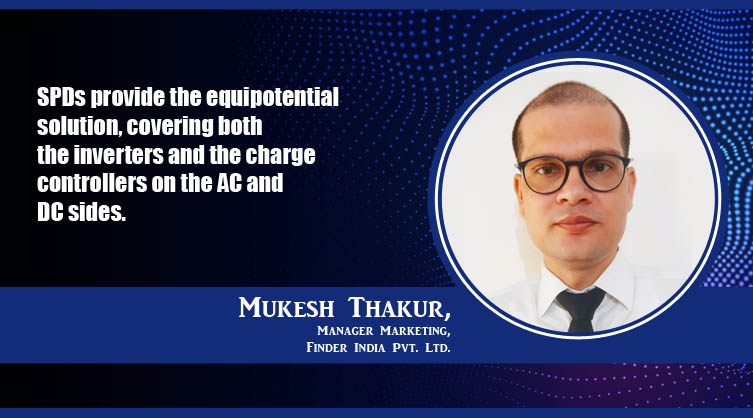SPDs can get better ROI from solar power systems
By EPR Magazine Editorial August 27, 2022 4:49 pm IST
By EPR Magazine Editorial August 27, 2022 4:49 pm IST

Importance of SPD in a solar-powered system
Solar-powered systems are exposed to frequent lightning and vulnerable to repeated and significant damage due to surges. These result in substantial repair and replacement costs, system downtime, and loss of revenue. Critical electronics design is getting more sensitive. Solar Power Systems start giving returns on investments within 5 to 7 years, so if there are stresses and breakdowns, ROIs are delayed, which means losses in revenue. Hence, SPDs are essential to protect sensitive electrical equipment like AC/ DC inverters, monitoring devices, and PV modules, but also other sensitive equipment powered by the 230 VAC electrical distribution network.
Protecting solar panels during high-lighting conditions
Lighting leads to three kinds of couplings: This galvanic coupling occurs when lightning strikes the ground near a building and causes a massive rise in ground voltage. This rise in ground voltage affects electrical earthing systems and is conducted back through them into the building, where it can travel through the electrical system. When a lightning strike strikes a lightning conductor that is part of a building’s structural protective system, it generates a sizeable electromagnetic pulse of energy nearby cables can pick up as a destructive voltage surge. Capacitive coupling occurs on overhead high-voltage power distribution cables during direct lightning strikes.
The SPDs provide the equipotential solution during the event of a surge occurrence, thereby protecting the inverters and the charge controllers both on the AC side as well as the DC side. The Metal Oxide Varistor inside the SPD has such propriety that in normal conditions (no overvoltages), the resistance is high enough to prevent possible nominal currents from passing through it. Starting at a certain overvoltage level, the resistance will quickly drop, opening the path to the ground and returning to a normal condition once the surge energy has been dissipated. This process allows the limitation of the overvoltage level to reach all the equipment connected downstream.
What are the most critical factors when selecting SPDs for a solar system?
Type 1 SPDs, which have a current wave of 10/350 s, protect against direct and indirect lightning strikes. Type 1 SPDs are used in central inverters. Type 2 SPDs protect against indirect lightning strikes, which are characterised by 8/20 μs waveforms. An 8/20 μs waveform means that the strike has an eight μs rise time and a duration to a one-half peak of 20 μs. Type 2 SPDs prevent the spread of overvoltage into electrical installations and equipment. They also protect against lightning’s electromagnetic effects, which can cause a surge within the wire. A type 2 SPD should be used on each MPPT and within string inverters and array boxes.
To ensure the proper selection of SPDs for the PV system and its installation, we must know:
The SPD requirements for an installation that is protected by an external lightning protection system (ELPS) depend on the separation distance between the ELPS and the PV installation as per IEC 62305-3 standards.
What are the critical parameters to consider while installing SPDs in a solar-powered electrical system?
PV sources have very different current and voltage characteristics than traditional DC sources, i.e., their non-linear characteristics and longer duration of ignited arcs. Therefore, the SPDs must also have a built-in disconnector to cope with PV currents. Surge protection is just as crucial for the ac side as it is for the dc side. Ensure that the SPD is specifically designed for the ac side.
SPDs should permanently be installed upstream of the devices they are going to protect. The proper installation of an SPD must consider the following factors:
We use cookies to personalize your experience. By continuing to visit this website you agree to our Terms & Conditions, Privacy Policy and Cookie Policy.